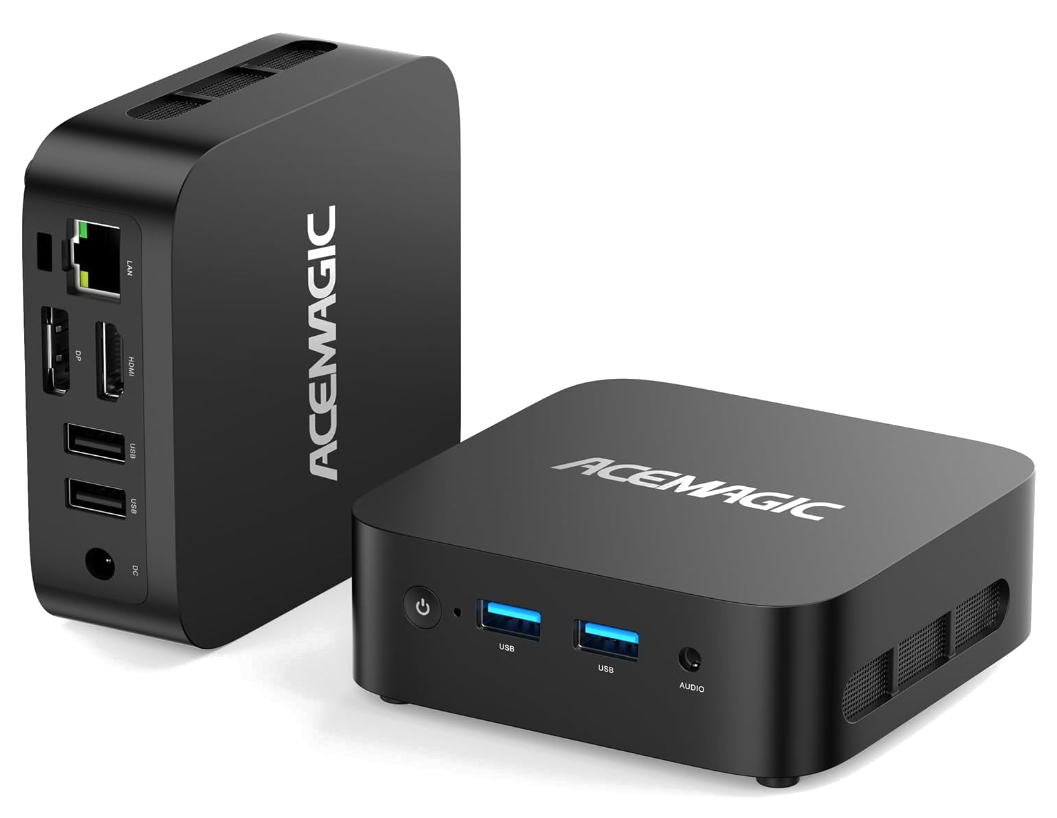
Acemagic Vista Mini V1 NotesRussell Bateman |
In June 2025, I was tempted by and purchased an ACEMAGICIAN Vista V1 Mini PC computer from Amazon for $149. It came with Windows 11 Pro installed which I was able able to set up without obligating myself to create a Microsoft account requiring log-in. Here are the details:

12th Generation Intel Alder Lake N95 (Beat N100, Up to 3.4GHz, 4 Cores) 16Gb DDR4 RAM 512Gb M.2 2280 SSD (Maximum 2Tg) Dual WiFi 5 Bluetooth 4.2 Intel UHD Graphics Axial Fan Internal Cooling Front Power button 2× 3.2 3.5mm Audio Jack Rear Gigabit Ethernet RJ-45 UHD 4K HDMI 2.0 (4K @ 60Hz) Display Port 1.4 (4K @ 60Hz) 2× 2.0 Power connector
I purchased this because the price and I need a replacement for my HP 17" touchscreen notebook running Windows 10 in order to run Turbotax software (which I have never been able to port to Wine.
Better yet, on another instance of this hardware. This would be so I can set up a Jellyfin server for my house (n support for outside subscribers). I wonder if it's possible to serve up the media from an external USB-mounted drive. I tried to do that with my existing Plex Media server and it never really worked (the mounted volume kept unmounting.
When installing Debian Linux on an Acemagic Vista Mini V1, the primary challenges involve accessing the BIOS for boot management and ensuring full driver compatibility for components like the NVMe drive and Wi-Fi card. While the system is based on standard x86 architecture and can run Linux, specific hardware can cause problems during or after installation.
See Microsoft forces on-line accounts.
If ever I decide to install Linux on this box...
From Acemagic: Our technical team has reviewed your issue and identified several potential causes:
Driver Incompatibility: The Bluetooth and Realtek Wi‑Fi drivers may not be fully compatible with the Linux kernel used in Ubuntu 24.04.
Power Management Issues: System freeze could be triggered by aggressive power-saving modes.
ACPI Deadlock: Errors in Bluetooth and Wi‑Fi drivers might be triggering ACPI events, which then cause the system to enter an unstable state and eventually deadlock. New Kernel Instability: Ubuntu 24.04 was released recently, and some drivers may not yet be fully stable on newer 6.x kernel versions.To troubleshoot and improve system stability, please try the following:
A common reason for a USB hard drive to keep unmounting on an Ubuntu server is insufficient or unstable power delivery, often resolved by disabling USB autosuspend, using a powered USB hub, or moving to a powered USB port. Other potential causes include faulty hardware like the drive, cable, or USB port, file system corruption, or the drive entering sleep mode, all of which can be investigated by checking system logs, testing different components, and disabling power-saving features.
Disable USB Autosupend:
This feature can cause the drive to disconnect. You can disable it by editing the cmdline.txt file or checking power management settings in the Ubuntu control panel.
Use a Powered USB Hub:
This provides dedicated power to the hard drive, preventing it from drawing too much power from the server's USB ports.
Try a Different USB Port:
Connect the hard drive to a different USB port on the server. If the problem stops, it indicates a faulty port.
Try a Powered External Drive:
If you are using a portable, bus-powered external drive, switch to a model that uses its own external power supply to ensure stable power.
This video shows how to fix mounting issues with a USB drive:
https://www.youtube.com/watch?v=utHUlE1d4SE
Test the USB Cable:
A damaged or low-quality USB cable can cause disconnections. Try a different, higher-quality USB cable.
Test the Hard Drive:
If you have another USB device, test it on the same port. If the other device also disconnects, the port or USB controller is likely the issue. Conversely, if the hard drive works fine on another computer, the issue might be with the server's USB ports.
Check for Drive Errors:
File system corruption or errors can cause a drive to become unstable. Use lsblk to identify the drive and fsck to check and repair the file system if needed.
Monitor Logs:
Check system logs, such as dmesg, for messages related to USB disconnects or host controller errors that can provide clues to the problem.
Check for Drive Sleep Mode:
Some hard drives enter sleep mode to save power. You can create a simple cron job to access a file on the drive every minute to prevent it from going to sleep.

To mound the computer to the back of a monitor (to hide it, get it off the desk, etc.), the monitor must offer standard VESA mounting holes. The bracket comes with two tiny black screws for mounting which are inserted through one of the two holes in a diagonal slot on either end of the bracket. This leaves two slide-in holes standing proud of the back of the monitor for slipping over two stand-off screws that also ship with the brack. These screws mount into two hole on the bottom of the computer.
If the VESA mount is obscured in some way either because the mounting point is already in use or the monitor stand itself is using them, this will not work.